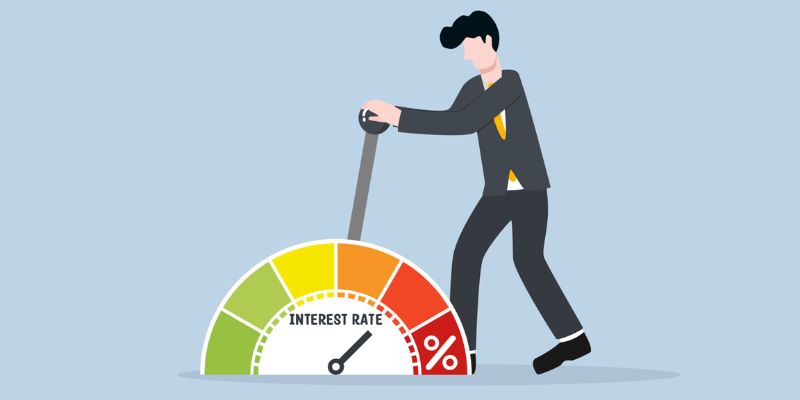Monetary Policy Decisions: How Interest Rates Shape Your Wallet
Let’s get real: monetary policy decisions and interest rates stir the financial pot. They touch everything from your mortgage to your savings account. Think of them as invisible hands reaching into your wallet, shaping how thick or thin it feels. In this breakdown, I’ll show you the ropes—how those big moves by central banks dictate what happens with your cash. We’ll dive into how a single rate tweak can sway your borrowing and saving dance moves. Also, we’ll tackle why those government bond buys matter to your investment game plan. Get ready to connect the dots between high-up policy shifts and the dollars in your pocket.
Understanding the Relationship Between Monetary Policy Decisions and Your Finances
How Interest Rate Adjustments Influence Personal Borrowing and Savings
When the central bank changes interest rates, it feels like a far-off event. But those few percentage points affect how much you pay for a loan or earn on savings. Higher rates mean loans cost more, and saving pays more. Lower rates do the opposite. Simple, right? Each time the Federal Reserve actions tweak these rates, they shape your wallet’s health.
Imagine you want a new car or a house. If rates go up, your dream car costs more each month. If rates drop, your payments shrink. The same goes for mortgages — small rate changes can add big bucks to or from your home’s total cost. It’s a similar deal with savings. More interest means more cash for you over time without lifting a finger.
Evaluating the Direct Impact of Open Market Operations on Investment Choices
Now let’s wade into open market operations, a fancy way of saying the central bank’s buy and sell game. It’s one of their top tools to control how much money flows in the economy. When they buy stuff like government debt, there’s more money for banks to loan out. This can make borrowing cheaper, and more people might buy stocks or bonds. On the other hand, if they sell, money gets tighter, and borrowing becomes pricier. That can slow folks down from snapping up investments.
These moves also send signals to markets about where the economy might be heading. Big investors and small savers like us try to read these signs. The goal? Figuring out if it’s time to stash cash or go big and invest. It’s all about staying ahead of changes so your wallet can come out on top.
Each decision from the rate-setting committee affects everyone: from big banks to our pocketbooks. It’s like a big financial web, weaving through every loan, savings account, and investment out there. Understand how they move the threads, and you’ll see how your cash flow shifts. With some smarts and a bit of luck, you can make these monetary policy moves work for you.

The Role of the Federal Reserve and How It Affects You
Deciphering the Federal Reserve’s Actions and Interest Rate Policy
Have you ever wondered how big decisions on money are made? I mean, the kind that impacts us all? Let’s talk about the Federal Reserve, or “Fed” for short. They are like the captain of our economic ship. One important job they have is tweaking interest rates. Think of this like a tool that can make borrowing money cheap or costly.
When interest rates drop, it’s like a sale at your favorite store, but for loans! It’s cheaper to borrow money for a house or a car. Businesses also invest more because loans don’t cost them as much. So, when the Fed cuts rates, they hope to boost spending and grow the economy. This is called expansionary policy.
On the flip side, if things are too heated, like prices rising super fast (we call this inflation), the Fed might hike up rates. Now, borrowing gets pricier. People and businesses put the brakes on spending, which cools things down. This is what we call contractionary policy.
Central Bank Governors and Rate-Setting Committee: Their Influence on Your Wallet
Now, who decides on these interest rate changes? Enter the central bank governors and a group known as the rate-setting committee. These folks watch the economy like hawks, keeping an eye on prices, jobs, and how much stuff we’re all buying.
If they see prices climbing too fast, they might say, “Hey, it’s time we make borrowing a bit tougher, so people don’t overspend.” This helps keep everything balanced. But if the economy is snoozing, they might lower rates to give it a gentle shake and wake it up.
What they decide ripples out to your wallet, believe it or not. Got a loan or credit card? Their interest rate decisions can affect your payments. And if you’re saving, you care about the interest you earn, right? So, their moves matter for your piggy bank, too.
But how do you know what they’ll decide? Well, they drop hints during policy rate announcements. They want to keep us all in the loop. If you hear them worried about inflation, brace yourself for possible rate hikes. If they’re aiming to spark the economy, they might be setting up for rate cuts.
By understanding the Fed’s actions, you’ll get a clearer picture of your financial future. You’ll see why your savings account interest might change or why your mortgage payments could adjust. Be smart, keep an eye on the Fed, and you’ll navigate your finances like a pro!
Remember, these central bank policies are big gears in our economic machine. By knowing how they turn, you’ll be better equipped to handle your money, plan ahead, and make savvy decisions. So the next time the Fed makes a move, you’ll understand exactly how it might play out in your day-to-day spending and saving.

Unpacking the Effects of Economic Stimulus on Consumer Spending
Expansionary vs. Contractionary Monetary Policy: What It Means for Your Purchasing Power
When central banks want us to spend more, they use expansionary policy. This means they cut rates. So, loans for cars or homes cost less. You can borrow more money, buy more stuff, and help businesses grow. More jobs may appear, and folks might get raises. It can feel like more cash is in your pocket.
But, if prices soar too high, the same banks might use contractionary policy. Here, they hike rates to slow spending. Loans cost more, and you think harder about spending. This can cool things off if the economy runs too hot. Yet, if they lift rates too much or too fast, folks might spend much less. This can hit jobs and growth hard.
It’s like having a gas pedal and a brake for the economy. Central banks press down or let up to keep our money’s value steady. They want to make sure we can buy what we need today and tomorrow.
Quantitative Easing and Inflation Targeting: Understanding Their Long-Term Impacts
You might hear about quantitative easing. It’s when central banks buy a lot of debt to pour cash into the economy. This can ease things when banks don’t lend or markets crash. It makes it cheaper to borrow and can help folks find jobs. But if used too much, it can make prices climb too fast.
Central banks also aim to keep prices stable, called inflation targeting. They want a small rise in prices, so things cost a bit more each year but not too much. This helps you plan for things like rent, food, and saving for school or retirement.
The long-term? If banks do it right, they can help us all spend and save better. They work to avoid wild swings in prices or in the economy. When they miss the mark, though, we can face tough times. Loans get pricey, cars and homes might not sell, and jobs can be harder to find.
But remember, it’s like a big team. The banks, the government, and us, we all play a part. We need to stay sharp and make smart choices with our money.
It’s not just about what banks do. It’s about how we react, too. We choose to spend or save based on what we expect. If we think prices will shoot up, we might buy now rather than later. But if we fear jobs might vanish, we might tuck away some cash.
So, let’s keep an eye on what the central banks do with rates. They guide where the economy might go. They shape how we live, work, and plan. We can’t control it all, but understanding helps us make better moves with our money.

Navigating the Future: Predicting Economic Trends Based on Monetary Policy
Yield Curve Analysis and Economic Outlook Forecasts: A Guide for Financial Planning
Picture this: You’re planning for a bright future. You’re thinking about buying a home, starting a business, or saving for retirement. But how do you know what the economy will look like next year, or even five years from now? One key tool experts use is yield curve analysis. It’s like a fortune teller for the economy.
The yield curve shows how much money you’ll earn from buying government debt. Simplifying a bit, it means looking at interest rates on short-term and long-term loans. When the curve goes up, it means people think the economy will grow, and interest rates will rise. That means your savings might pay more over time.
But when the curve flips, and short-term rates are higher, it’s often a signal that rough times are ahead. People fear that the economy might slow down, so they push for more money now, not later. This flip can affect jobs, house prices, and how much stuff costs.
How Policy Rate Announcements Can Shape Market Expectations and Personal Investment Strategies
Now, let’s chat about policy rate announcements. Central banks, like the Federal Reserve, change rates to keep the economy stable. When they lower rates, they’re saying, “Please spend and invest more.” It’s cheaper to borrow money, which can be great for your wallet if you’re looking to get a mortgage or loan.
On the other hand, if the rates climb, the central bank is signaling, “Let’s take it easy with spending.” This can make loans more expensive, but it’s good news for what you earn on your savings.
Every time the central bank talks rates, people who buy and sell stocks and bonds listen closely. They try to guess what will happen next and this can move markets in big ways. That’s why it’s a smart move to pay attention to these tips from the big banks. It can help you decide when to borrow, when to save more, or when to invest in stocks.
For example, if rates are expected to rise, it might be smart to lock in a fixed-rate mortgage soon. Or if they’re set to drop, you could wait a little before you refinance your home loan – the lower rates could save you money on interest.
So next time you read about the Federal Reserve or hear about interest rates on the news, remember it’s not just talk. It’s a sign for you — to help you decide what to do with your cash. Keep an eye on the yield curve and policy rate hints. They can guide you through the wild world of money and planning. Consider them your map and compass for your financial adventure. They won’t tell you every rock or tree you’ll find, but they’ll help you choose the right path.
In this post, we broke down how money policy shifts can hit your wallet. We looked at how changes in interest rates affect your loans and savings. We saw how the Fed’s moves touch your money every day.
We also learned how buying and selling by the Fed changes what you do with your cash. Those big bank decisions? They matter in your daily life.
We explained how stimulus actions shape what you buy and how much. Whether the policy is wide open or tight, it changes your buying power.
Lastly, we dove into how to use economic signs to plan for your money’s future. We unpacked how policy news can guide your choices on saving and investing.
Here’s the takeaway: Stay sharp and use what you learn about the economy. It can help you make smart choices for your future. Always keep an eye on the Fed’s next steps. They’re more than just news – they’re your financial forecast.
Q&A :
How do monetary policy decisions affect interest rates?
Monetary policy decisions are pivotal in determining the benchmark interest rates set by a central bank. When a central bank, such as the Federal Reserve in the United States, decides to curb inflation or stimulate economic growth, it can either raise or lower interest rates, respectively. An increase in interest rates typically cools economic activity by making loans more expensive, while a decrease is intended to encourage borrowing and investment by making loans cheaper. These decisions can ripple throughout the economy, influencing everything from consumer spending to business expansion and the housing market.
What is the main goal of monetary policy in relation to interest rates?
The primary goal of monetary policy in relation to interest rates is to maintain price stability and support sustainable economic growth. Central banks aim to achieve an optimal balance where inflation is kept within a target range, avoiding both excessive inflation and deflation. Managing interest rates allows central banks to control the money supply and demand, which subsequently stabilizes prices and guides the economy towards full employment.
How often do monetary policy decisions occur?
Monetary policy decisions occur at regular intervals, which can vary among different central banks. For example, the Federal Reserve’s Federal Open Market Committee (FOMC) meets eight times a year to review economic conditions and determine the monetary policy stance. These scheduled meetings are critical events for financial markets as they often result in adjustments to interest rates, which can influence investment, consumption, and savings behavior.
Can changes in monetary policy decisions impact mortgage rates?
Yes, changes in monetary policy decisions can have a significant impact on mortgage rates. When a central bank changes its key interest rate, it influences the rates that commercial banks charge their customers. An increase in the central bank’s rate can lead to higher mortgage rates, raising the cost of borrowing for homebuyers. Conversely, when the central bank lowers the interest rate, mortgage rates can fall, making it cheaper to finance a new home purchase or to refinance existing loans.
Why do central banks sometimes diverge in their monetary policy decisions?
Central banks may diverge in their monetary policy decisions due to differing economic conditions and policy objectives in their respective countries. Factors such as inflation rates, employment levels, economic growth rates, and financial stability concerns influence policy decisions. Additionally, each country has its own set of economic challenges and goals, which means that what might be a suitable policy for one might not be appropriate for another. As a result, central banks tailor their monetary policies to address their specific economic environments and to meet their individual mandates.

